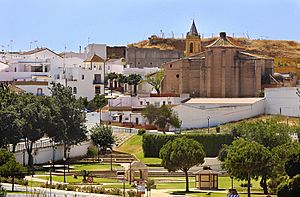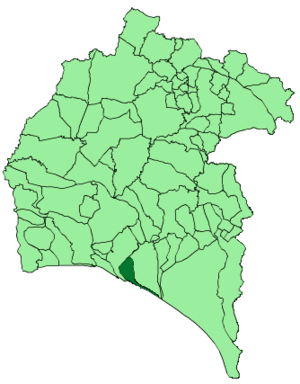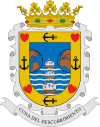Palos de la Frontera facts for kids
Quick facts for kids
Palos de la Frontera, Spain
|
|||
|---|---|---|---|

Panoramic view of downtown Palos de la Frontera
|
|||
|
|||

Location of Palos de la Frontera
|
|||
| Province | Huelva | ||
| Area | |||
| • Total | 50 km2 (20 sq mi) | ||
| • Land | 50 km2 (20 sq mi) | ||
| • Water | 0.00 km2 (0 sq mi) | ||
| Population
(2018)
|
|||
| • Total | 11,112 | ||
| • Density | 222/km2 (580/sq mi) | ||
| Demonym(s) | palermos (m.), palermas (f.) | ||
| Time zone | UTC+1 (CET) | ||
| • Summer (DST) | UTC+2 (CEST) | ||
| Website | www.palosfrontera.com | ||
Palos de la Frontera is a town in southwestern Spain. It's located in the Huelva province, which is part of the Andalusia region. It's about 13 kilometers (8 miles) from Huelva, the main city of the province. In 2015, about 10,365 people lived there.
Palos de la Frontera is most famous because Christopher Columbus started his first journey to the Americas from here in 1492.
Contents
History of Palos de la Frontera
The town of Palos was officially founded in 1322. At that time, Alfonso XI of Castile gave the town to Alonso Carro and his wife. However, people might have lived in this area much earlier. Evidence shows that Paleolithic people, Tartessians, Romans, Visigoths, and Muslims lived here.
The name "Palos" comes from the Latin word palus, which means "lagoon." The town added "de la Frontera" to its name in May 1642.
Early Days and Growth
When Palos was first established, it was part of the Almohad kingdom of Niebla. It was a small village where people mostly fished. The town's location helped protect it from pirates and storms.
Álvar Pérez is often seen as the true founder of the city. In 1379, when he was only 14, Juan I of Castile gave him the towns of Palos and Villalba del Alcor. Álvar Pérez was allowed to tax the first 50 families who settled in Palos. He also started growing olive trees and making olive oil in the area. After Álvar Pérez died, his wife, Elvira de Ayala, continued his work until 1434.
The Golden Age of Palos
The 15th century was Palos's "Golden Age," especially between 1470 and 1479. During this time, the town grew to 2,500 people. Its economy became very strong, thanks to fishing and sea trips to Guinea.
Palos sailors were known for their excellent navigation skills. They often helped Castilian ships during the War of the Castilian Succession against Portugal. A writer named Alfonso de Palencia said that "only the men of Palos know the ancient sea of Guinea."
However, Castile lost the war. In the Treaty of Alcáçovas (1479), Ferdinand and Isabella agreed that Portugal would control most of the Atlantic trade routes. Only the Canary Islands remained Castilian. Despite this, many Palos sailors continued to sail into Portuguese waters.
Columbus's Journey
On August 3, 1492, three famous ships, the Pinta, Niña, and Santa María, sailed from Palos. On board were Christopher Columbus and the Pinzón Brothers, who were from Palos.
Before his journey, Columbus met with Franciscans at the Rábida Monastery in Palos. He discussed his plans for finding a new route to Asia. The three ships landed in the Americas on October 12, 1492. The Santa María was lost in American waters, but the Pinta and Niña returned to Palos on March 15, 1493.
Palos and the New World
Palos played a big part in settling and spreading Christianity in the Americas. The Rábida Monastery was important for this mission. Many of the first missionaries were from Palos. These included Juan Izquierdo, Juan de Palos, and Francisco Camacho.
Decline and Revival
In 1503, the Casa de Contratación (House of Trade) was set up in Seville. This caused Palos to decline because trade moved to Seville. Many people from Palos moved to America or Seville. By the 18th century, only about 125 people lived in the town.
However, things changed in the 18th century. Investors from Catalonia started a viticultural (grape-growing) industry in Palos. The population slowly grew back to its earlier numbers. Palos also became a center for the shrimp industry. Today, it's also famous for its "fresón de Palos," which are garden strawberries exported to the European Union.
Modern History
On June 22, 1926, the first hydroplane to cross the Atlantic took off from Palos. This was the Plus Ultra flying boat. It flew in six stages and landed in Buenos Aires, Argentina. Alfonso XIII of Spain gave the Plus Ultra to the Argentine Navy. In return, Argentina gave Spain a statue of Icarus, which is now at La Rábida. Alfonso XIII also made Palos a city around this time.
John Paul II visited Palos on June 14, 1993. He was the only pope to visit the city. During his visit, John Paul symbolically crowned the town's patron saint, the Virgin of Miracles.
There is a station in the Madrid Metro subway system named after Palos de la Frontera.
Palos in the United States
In 1850, a small town in Illinois, near Chicago, changed its name to Palos. This idea came from M. S. Powell, the local postmaster. His ancestor, Pedro Alonso Niño, had sailed with Christopher Columbus from Palos de la Frontera. Later, in 1914, Palos became a village called Palos Park. The nearby towns of Palos Hills and Palos Heights were founded later. All three towns are in Palos Township.
Sister Cities
 Cali, Colombia
Cali, Colombia Latina, Italy
Latina, Italy Lagos, Portugal
Lagos, Portugal
See also
 In Spanish: Palos de la Frontera para niños
In Spanish: Palos de la Frontera para niños



